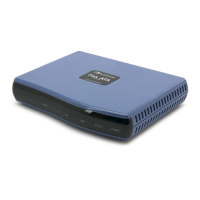Version 3.0.1 77 July 2010
MP-20x Telephone Adapter 8. Quality of Service (QoS)
Furthermore, MP-20x cannot control the behavior of its WAN MP-20x (usually the ISP),
which may not have proper QoS handling. Unfortunately, this is a common situation. Let’s
look at a scenario of downloading a large file and surfing the Internet at the same time.
Downloading the file is distinguished by small requests, followed by very large responses.
This may result in blocking HTML traffic at the ISP. A solution for such a situation is limiting
the bandwidth of low-priority TCP connections (such as the file download).
To add outbound/inbound class rules, refer to 'Traffic Priority' on page 77.
Note: The hierarchy of the class rules is determined by the order of their addition to
the class. For example, if your first rule is 'match packets with any source
address, any destination address, and any protocol to this class; then all
packets traveling through MP-20x are associated with the specific class. Any
rules defined later do not have any effect.
8.3 Traffic Priority
Traffic Priority allows you to manage and avoid traffic congestion by defining inbound and
outbound priority rules for each device on your MP-20x. These rules determine the priority
assigned to packets traveling through the device. QoS parameters (DSCP marking and
packet priority) are set per packet, on an application basis.
You can set QoS parameters using flexible rules, according to the following parameters:
Source/destination IP address, MAC address or host name
Device
Source/destination ports
Limit the rule for specific days and hours; MP-20x supports two priority marking methods
for packet prioritization:
DSCP
802.1p Priority
The matching of packets by rules is connection-based, known as Stateful Packet
Inspection (SPI), using the same connection-tracking mechanism used by firewall. Once a
packet matches a rule, all subsequent packets with the same attributes receive the same
QoS parameters, both inbound and outbound.
A packet can match more than one rule. Therefore:
The first class rule has precedence over all other class rules (scanning is stopped
once the first rule is reached).
The first traffic-priority (classless) rule has precedence over all other traffic-priority
rules.
There is no prevention of a traffic-priority rule conflicting with a class rule. In this case,
the priority and DSCP setting of the class rule (if given) takes precedence.

